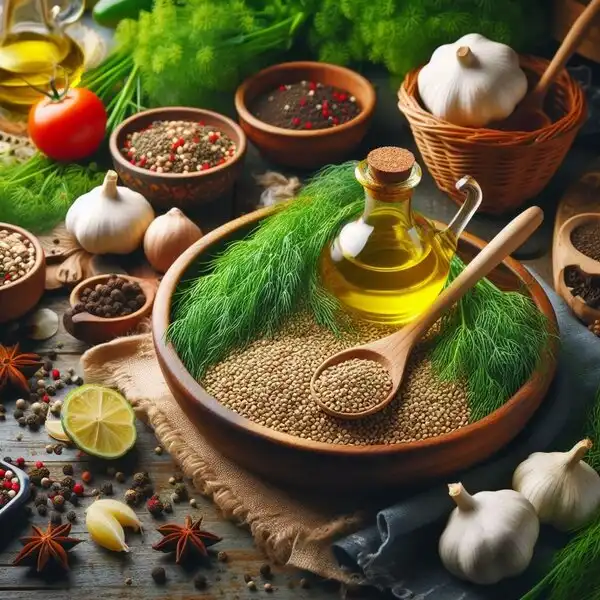Mastering the Art of Growing and Using Dill: A Comprehensive Guide
Introduction
Dill, with its feathery foliage and distinct aroma, has long been cherished for its culinary and medicinal properties. From adding flavor to pickles to aiding digestion, this versatile herb holds a special place in the hearts of both home cooks and homesteaders. In this comprehensive guide, we'll delve into the art of growing and using dill, exploring its benefits, cultivation techniques, and more.

Why Dill Holds a Special Place in the Homesteader's Heart
A Culinary Staple: Dill is more than just a garnish; it's a key ingredient in a wide array of dishes. From enhancing the flavor of pickles to seasoning fish and vegetables, its uses are endless.
Medicinal Marvel: Beyond its culinary uses, dill boasts medicinal properties. It aids digestion, eases stomach discomfort, and even helps alleviate menstrual pain.
Garden Charm: Growing dill isn't just practical; it's also aesthetically pleasing. Its delicate foliage and vibrant yellow flowers add beauty to any garden, whether it's a cottage garden, container garden, or part of a larger vegetable patch.
The Joy of Growing Dill at Home
There's something deeply satisfying about cultivating your own herbs, and dill is no exception. Here's why growing dill at home is a rewarding experience:
Freshness: Picking dill straight from your garden ensures unparalleled freshness, enhancing the flavor of your culinary creations.
Connection to Nature: Tending to a dill plant fosters a deeper connection to the natural world, allowing you to appreciate the cycles of growth and harvest.
Self-Sufficiency: By growing your own dill, you reduce reliance on store-bought herbs, promoting self-sufficiency and sustainability.
Benefits for Cooking and Health
Enhanced Flavor: Nothing beats the taste of freshly harvested dill. Its bright, citrusy notes elevate dishes ranging from salads to soups.
Digestive Support: Dill's carminative properties make it an excellent aid for digestion. Whether you're battling bloating or indigestion, a cup of dill tea can work wonders.
Conclusion
In conclusion, growing dill at home isn't just about cultivating a herb; it's about embracing a lifestyle of self-sufficiency and wellness. By incorporating dill into your culinary and medicinal practices, you can enhance both the flavor of your meals and your overall well-being. So, why not embark on your own journey of dill cultivation today?
Mastering the Art of Growing and Using Dill: A Comprehensive Guide
Why Growing Dill is a Homesteader's Delight
Dill, with its myriad of benefits, holds a special place in the hearts of homesteaders. Here, we'll explore why cultivating dill at home is not just a hobby but a deeply rewarding experience.
Personal Anecdotes and Experiences
Connection to Nature: Many homesteaders find solace in nurturing plants like dill. The act of sowing seeds, tending to seedlings, and finally harvesting fresh herbs offers a profound connection to the natural world.
Satisfaction of Self-Sufficiency: Growing dill at home aligns with the ethos of self-sufficiency that many homesteaders espouse. By cultivating their own herbs, they reduce reliance on store-bought alternatives and gain a sense of independence.
Tangible Rewards: There's nothing quite like the feeling of harvesting a bunch of fresh dill from your garden and incorporating it into your cooking. The tangible rewards of homegrown herbs far surpass those of store-bought varieties.
Incorporating Dill into Various Garden Setups
Dill is a versatile herb that can thrive in various garden setups, catering to the needs and preferences of different homesteaders.
Cottage Gardens: Dill's delicate foliage and charming flowers make it a perfect addition to cottage gardens, adding both beauty and functionality to these quaint spaces.
Container Gardens: For homesteaders with limited space, dill can be grown successfully in containers on patios, balconies, or even windowsills, providing a convenient source of fresh herbs.
Vegetable Gardens: In vegetable gardens, dill serves as more than just a companion plant; it's a valuable ally in pest control, attracting beneficial insects that prey on common garden pests.
Medicinal Properties and Digestive Support
Beyond its culinary uses, dill boasts medicinal properties that have been cherished for centuries.
Digestive Health: Dill has long been used to aid digestion, with its carminative properties helping to alleviate bloating, gas, and indigestion.
Natural Remedies: Many homesteaders turn to dill as a natural remedy for digestive ailments, preferring it over conventional medications due to its gentle yet effective nature.
Holistic Wellness: Embracing dill's medicinal properties is part of a holistic approach to wellness that many homesteaders advocate, prioritizing natural remedies over pharmaceutical interventions.
Key Takeaways
Cultivating dill at home offers a myriad of benefits, from enhanced flavor in cooking to holistic wellness.
Dill can be incorporated into various garden setups, catering to the preferences and constraints of different homesteaders.
Its medicinal properties make it a valuable addition to any homesteader's herbal arsenal, particularly for digestive health.
Stay tuned for the next section, where we'll delve into the different varieties of dill and their culinary applications!
Mastering the Art of Growing and Using Dill: A Comprehensive Guide
Exploring Dill Varieties and Culinary Applications
Dill comes in various varieties, each offering its own unique flavor profile and culinary possibilities. Let's dive into the world of dill varieties and discover the many ways you can incorporate this versatile herb into your cooking.
Introduction to Different Dill Varieties
Bouquet Dill: This is the most commonly grown variety, known for its delicate foliage and mild flavor. It's perfect for pickling and adds a subtle, refreshing touch to salads and seafood dishes.
Fernleaf Dill: As the name suggests, this variety has fern-like foliage that adds visual interest to your garden. It has a slightly stronger flavor than bouquet dill, making it ideal for seasoning grilled meats and roasted vegetables.
Dukat Dill: Dukat dill is prized for its exceptional flavor, which is more intense and aromatic than other varieties. It's often used in recipes where dill plays a starring role, such as dill sauce for salmon or dill-infused soups.
Culinary Applications Beyond Pickling
While dill is perhaps best known for its role in pickling, its culinary uses extend far beyond that. Here are some creative ways to incorporate dill into your cooking:
Seasoning Fish: Dill pairs beautifully with fish, enhancing its natural flavors without overpowering them. Try sprinkling chopped dill over grilled salmon or adding it to fish marinades for a burst of freshness.
Enhancing Poultry: Whether you're roasting a chicken or grilling turkey burgers, dill can elevate poultry dishes to new heights. Mix chopped dill into ground meat for flavorful meatballs or incorporate it into stuffing for added depth of flavor.
Adding Zing to Eggs: Dill and eggs are a match made in culinary heaven. Add chopped dill to scrambled eggs, omelets, or frittatas for a burst of flavor and vibrant color.
Creative Ideas for Dill in Salads, Dips, and Sauces
Dill's bright, citrusy flavor makes it a welcome addition to a wide range of dishes. Here are some creative ways to use dill in your kitchen:
Refreshing Salads: Toss chopped dill into green salads, potato salads, or pasta salads for a refreshing twist. Its bright flavor pairs well with crisp vegetables and tangy dressings.
Flavorful Dips: Whip up a batch of creamy dill dip by combining sour cream, mayonnaise, garlic, and chopped dill. Serve it alongside fresh vegetables or crunchy pita chips for a crowd-pleasing appetizer.
Versatile Sauces: Dill sauce is a classic accompaniment to seafood, but its uses don't stop there. Drizzle dill sauce over grilled vegetables, roasted potatoes, or grilled chicken for a burst of flavor.
Highlighting Dill's Medicinal Properties
In addition to its culinary uses, dill boasts a range of medicinal properties that have been valued for centuries. Here are some traditional uses for dill in herbal medicine:
Digestive Aid: Dill is known for its carminative properties, which help soothe digestive discomfort and alleviate bloating and gas.
Menstrual Support: Dill has been used traditionally to ease menstrual cramps and promote hormonal balance in women.
Mood Booster: Some studies suggest that dill may have mood-enhancing properties, helping to alleviate symptoms of depression and anxiety.
Key Takeaways
Dill comes in various varieties, each with its own unique flavor and culinary applications.
Beyond pickling, dill can be used to season fish, poultry, eggs, salads, dips, sauces, and more.
Dill's medicinal properties make it a valuable addition to herbal medicine cabinets, particularly for digestive health and menstrual support.
Stay tuned for the next section, where we'll delve into the art of growing and preserving dill!
Mastering the Art of Growing and Using Dill: A Comprehensive Guide
Mastering the Art of Growing and Preserving Dill
Now that we've explored the culinary delights and medicinal wonders of dill, it's time to dive into the practical aspects of growing and preserving this versatile herb. Whether you're a seasoned gardener or a novice homesteader, mastering the art of dill cultivation and preservation will enrich your culinary endeavors and enhance your self-sufficiency.
Step-by-Step Guide on How to Grow Dill from Seed
Growing dill from seed is a straightforward process that requires minimal effort and resources. Here's a step-by-step guide to get you started:
Selecting the Right Location: Choose a sunny spot in your garden with well-drained soil. Dill thrives in full sunlight and prefers soil that's rich in organic matter.
Planting Dill Seeds: Sow dill seeds directly into the ground in early spring, once the danger of frost has passed. Scatter the seeds thinly and cover them lightly with soil. Water gently to keep the soil moist but not waterlogged.
Caring for Dill Seedlings: Once the seedlings emerge, thin them to ensure adequate spacing. Water dill plants regularly, especially during dry periods, and mulch around the base of the plants to retain moisture and suppress weeds.
Harvesting Dill: Dill plants will mature in about 6-8 weeks after planting. Harvest the leaves and stems as needed, using scissors or shears to cut them just above the soil line. Avoid over-harvesting to allow the plants to continue producing foliage.
Overview of Planting, Growing, Harvesting, and Preserving Processes
While dill is relatively low-maintenance, there are some key considerations to keep in mind throughout the growing season:
Watering: Dill plants prefer consistently moist soil, so water them regularly, especially during hot, dry weather.
Fertilizing: Dill doesn't require heavy feeding, but you can apply a balanced fertilizer once or twice during the growing season to promote healthy growth.
Harvesting: Harvest dill leaves and stems when they're young and tender for the best flavor. Snip off the outermost leaves first, leaving the inner growth intact to continue producing foliage.
Discussion on Different Preservation Methods for Dill
Preserving dill allows you to enjoy its flavor and medicinal properties year-round. Here are some popular preservation methods to consider:
Drying: Hang bunches of dill upside down in a warm, well-ventilated area until dry. Once dried, store the leaves in an airtight container away from light and heat.
Dehydrating: Use a food dehydrator to dry dill quickly and efficiently. Spread the leaves in a single layer on the dehydrator trays and dry them according to the manufacturer's instructions.
Freezing: Freeze dill leaves whole or chopped in freezer-safe bags or containers. Alternatively, freeze dill in ice cube trays with water or oil for easy portioning.
Invitation to Further Explore Homesteading Skills
Growing and preserving dill is just the beginning of your homesteading journey. Consider expanding your skills by exploring other aspects of self-sufficiency, such as fermentation, seed saving, or herbal medicine.
Key Takeaways
Growing dill from seed is a simple and rewarding process that requires minimal maintenance.
Proper care and harvesting techniques will ensure a bountiful supply of fresh dill throughout the growing season.
Preserving dill through drying, dehydrating, or freezing allows you to enjoy its flavor and benefits year-round.
With these tips and techniques, you're well on your way to mastering the art of growing and using dill in your culinary creations!

 Emma
Emma

